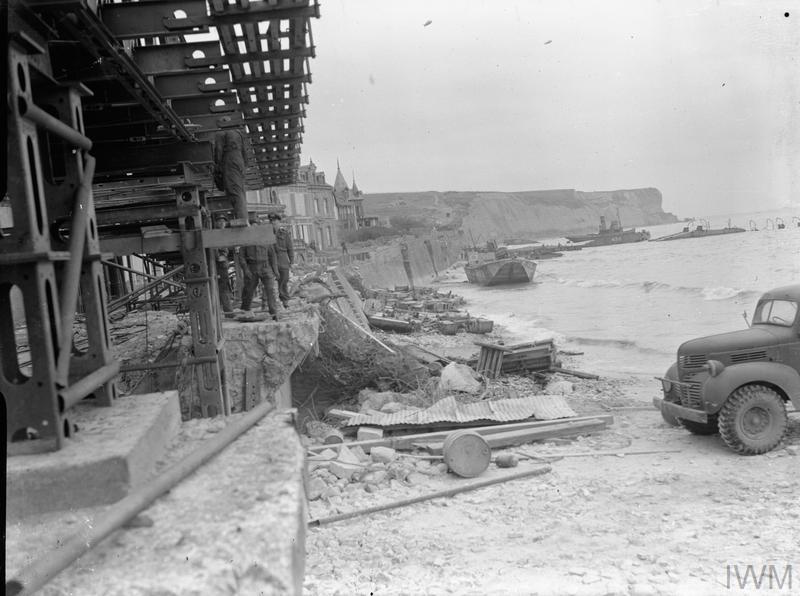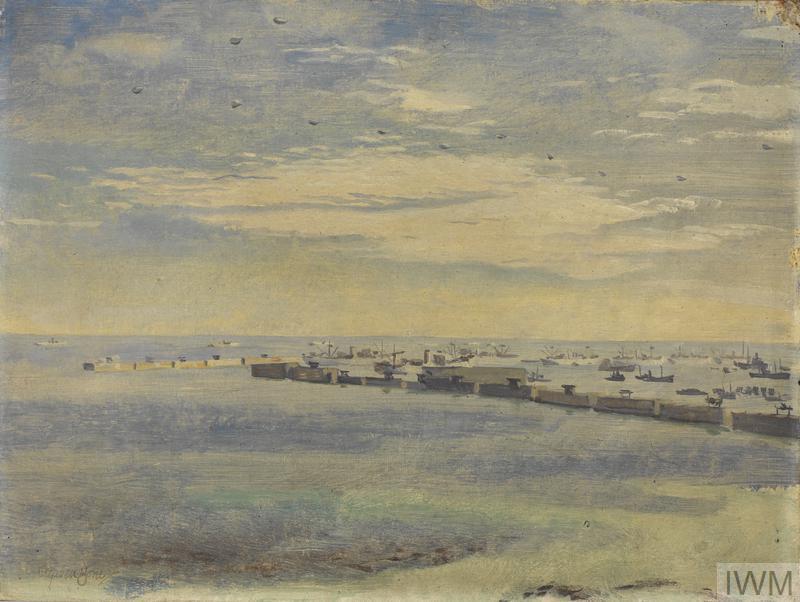No. 991 R.A.F. Beach Balloon Squadron consisting of Nos. 56 and 57 Beach Balloon Flights, helped to protect the ‘Mulberry B’ harbour at Arromanches in Normandy, France during Operation OVERLORD.
April 1944
The Squadron was formed on 17th April 1944 when Acting Squadron Leader P.L.W. Morton, 90291, Auxiliary Air Force, was posted from No. 993 Port Balloon Squadron to command the new squadron. Also posted in were Flight Lieutenant G.M.C. Dale, 76247, R.A.F.V.R., A. & S.D. Branch for Admin. (B) duties, F/Lt. A.S. Clarke, 85498, R.A.F.V.R., Balloon Branch, for balloon duties and Flying Officer A.B. Clark, 107565, R.A.F.V.R., Equipment Branch, for equipment duties. Some Airmen also, were posted from No. 993 Squadron.
The Squadron was formed to administer No. 56 Balloon Flight, commanded by F/Lt. L.A. Smith 81947 R.A.F.V.R. Balloon Branch and No. 57 Balloon Flight, commanded by Acting F/Lt. G.W.C. Lake 87075 R.A.F.V.R. Balloon Branch.
At the time of formation, the Squadron was deployed at The Grange, Grange Road, Erdington, Birmingham 24 (1” Ordnance Survey Sheet 72, reference 567127), the Flights being at No. 6 Balloon Centre, Wythall. On 20th April, the Flights joined the Squadron at Erdington.
Squadron Leader J.S. Stevens, H.Q. Balloon Command, visited the Squadron on 21st April with reference to questions of organisation. F/O A.E. McElhinney, 106791, R.A.F.V.R., Balloon Branch was posted as an additional officer to No. 57 Balloon Flight on 22nd April, No. 56 Balloon Flight already having F/O J.D. Harris, 102171, R.A.F.V.R., Balloon Branch.
On 26th April, the Squadron was transferred to 2nd Tactical Air Force but remained as a lodger unit under the administration of No. 6 Balloon Centre, Wythall, pending further instructions.
S/Ldr. Ellor, R.A.F. Movement Control, Birmingham visited the Squadron on 29th April, for liaison purposes in respect of any future movements of the unit.
Training was carried out throughout this period, and equipment drawn. The general health of personnel was good, with no infectious diseases reported. First Typhus inoculations were had on 20th April.
The strength of the unit as at 30th April was as follows:
Squadron H.Q. – 4 Officers, 1 Warrant Officer, 18 Other Ranks.
56 Balloon Flight – 2 Officers, 65 Other Ranks.
57 Balloon Flight – 2 Officers, 65 Other Ranks.
May 1944
On 1st May the Squadron carried out a full-scale practice deployment at Bartley Green. Sixty balloons were inflated and flown.
Due to sickness, F/Lt. L.A. Smith from No. 56 B. Flight was posted supernumerary to No. 6 Balloon Centre on 2nd May. Wing Commander N.H. Thomson, Balloon Command, visited the Squadron on 3rd May and on the 4th May the Squadron returned from deployment. On 8th May, F/Lt. N.F. Downing, 81951, R.A.F.V.R., Balloon Branch, was posted from No. 107 P. Flight to command No. 56 B. Flight in place of F/Lt. Smith.
On 10th May, 991 Beach Balloon Squadron, accompanied by No. 104 P. Flight moved to Leigh-on-Sea, Essex. The units were accommodated and rationed under Army arrangements.
S/Ldr. J.H. Gates, Balloon Liaison Officer, H.Q. 2nd Tactical Air Force and F/Lt. E.R. Styles, 2nd T.A.F. Command Accounts, visited the Squadron on 17th May.
On 21st May, 991 Beach Balloon Squadron and No. 104 P. Flight moved from Leigh-on-Sea to No. 12 Balloon Centre, Titchfield, Hampshire.
June 1944
At Titchfield on the morning of 1st June, the Squadron was put at 6 hours readiness to move to the Concentration Area and at 09.00 hours the next day, the Squadron moved to the R.A.F. Concentration Area at Old Sarum. The first stage of waterproofing was applied to their vehicles.
The Squadron moved to Marshalling Area C7 at Southampton on 7th June. Nos. 56 and 57 Balloon Flights moved on to Marshalling Area C3 at 17.00 hours. Second Stage waterproofing was applied to vehicles.
On 9th June, No. 991 Squadron (H.Q.) embarked on H.M.S. L.S.T. 159 at 17.00 hours, while Nos. 56 and 57 Balloon Flights embarked on H.M.S. L.S.T. 319 at 20.00 hours.
Landing in Normandy
On 10th June, No. 991 Squadron (H.Q.) disembarked at JIG Beach, East of Le Hamel at 18.00 hours and proceeded to Arromanches. Nos. 56 and 57 Balloon Flights disembarked at KING Beach, La Riviere at 21.30 hours, arriving at Arromanches at 14.30 the next day. Equipment was collected and unloaded.
A reconnaissance of sites was made on 12th June, while the collection of equipment continued. Nine balloons were inflated and flown as a commencement of the landward barrage of 30 balloons protecting Mulberry B port. The weather was fine with light westerly winds of 5-10 m.p.h.
Next day, 12 further balloons were inflated on land sites, some difficulty being experienced owing to uncleared minefields. One balloon casualty was replaced. Mean weather, showery….., fresh westerly wind, 15-20 m.p.h.
On 14th June the landward barrage was completed by 20.00 hours, with 9 further balloons inflated on land sites. This barrage was to be flown continuously at operational height, i.e. 2,000 feet (or cloud base during the hours of daylight). Four balloons were inflated on waterborne sites, 56 Balloon Flight maintaining the landward barrage and 57 Balloon Flight the waterborne. The mean weather was fair becoming fine, wind westerly 10-20 m.p.h., moderating.
One balloon casualty, caused by A.A. shell splinters, occurred on 15th June. This was replaced and nine waterborne balloons were inflated and flown. One of these became a casualty and was replaced. The mean weather was fair to fine, wind westerly 5-10 m.p.h.
On 16th June, one landborne and two waterborne balloon casualties were replaced. The weather was cloudy, 9-10/10ths low cloud at first becoming 7/10ths at 5-7,000 feet. High westerly wind, 10-15 increasing.
The personnel of the Squadron Headquarters and Flights moved their accommodation to Tracy sur Mer (837862) on 17th June, but an operational headquarters was retained in Arromanches. Three balloon casualties were replaced; one landborne and two waterborne. The weather was fair to fine, wind NW 10-15 m.p.h.
The next day, there was a suspected (unconfirmed) impact on one landborne balloon and three other balloon casualties. All four balloons were replaced. The wind was increasing, Northerly 15-20 m.p.h.
The Storm
On 19th June, the day opened with rain and squalls, with wind rising at times to gale force. It was therefore not possible to reach a number of the waterborne sites. Later, it was necessary to evacuate several of these. A landborne balloon casualty was not replaced owing to the weather conditions. The mean weather was 10/10ths low cloud, continuous rain, and a Northerly gale gusting to 45 m.p.h.
The weather the next day was the same, except the rain was intermittant. There were two more balloon casualties (one landborne and one waterborne) that could not be replaced because of the weather.
There was no rain on 21st June but otherwise weather conditions were similar. There was another landborne balloon casualty and again, this could not be replaced.
The Northerly wind was moderating on 22nd June. Two of the waterborne balloon casualties were replaced, so that there were 14 waterborne balloons flying. There was a further landborne balloon casualty and three landborne balloons were replaced, so that there were 29 landborne balloons flying. Cloud cover was 7/10ths.
On 23rd June there was one landborne balloon casualty. Two landborne and two waterborne balloons were replaced bringing the number of flying balloons to 30 landborne and 14 waterborne. The weather was now fair to fine, with a 10-15 m.p.h. Westerly wind.
The weather was fine on 24th June with light, variable wind. One waterborne casualty was replaced and two additional balloons were inflated, making a total of 16 waterborne balloons flown.

Balloons flown by 991 Balloon Squadron can be seen in the background.
(Picture by Lt. L. Pelman, Royal Navy official photographer © IWM A 24374)
Weather on 25th June remained fine but on 26th June there were thundery showers throughout the day. Lightning caused balloon casualties. The weather was showery and breezy for the next two days and then on the evening of 29th June, there was a violent thunderstorm.
Apart from continuing balloon casualties being replaced, additional waterborne sites were flown so that at the end of the month the total barrage was 22 waterborne and 30 landborne balloons.
Six ex Royal Navy and Merchant Navy balloons were serviced on shore by the Squadron during the month.
On 30th June the Squadron strength was 8 Officers, 1 Warrant Officer and 150 Other Ranks. Also, 5 Other Ranks were attached pending posting. The general health of the men was good, with no infectious diseases reported.
to be continued…….

(Oil painting by Stephen Bone © IWMArt.IWM ART LD 4611)
